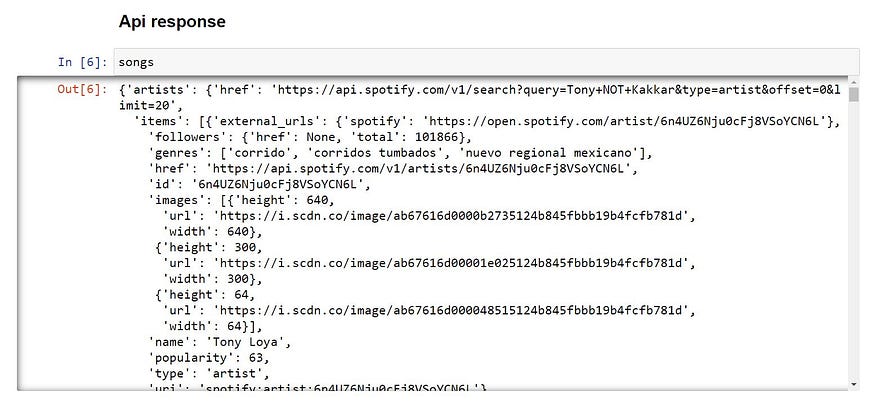How the code works :-
Libraries required
import base64 import requests import datetime from urllib.parse import urlencode
Get your API credentials from Spotify developer account
client_id = ‘client id’ client_key = “enter the key”
Initialize the client
class SpotifyApi(object):
access_token = None
access_token_expires = datetime.datetime.now()
access_token_did_expires = True
client_id = None
client_key = None
token_url = ‘https://accounts.spotify.com/api/token'
Authentication
def __init__(self, client_id, client_key, *args, **kwargs):
super().__init__(*args, **kwargs)
self.client_id = client_id
self.client_key = client_key
# Converting the credentials to base64 encoding
def get_token_header(self):
cred_base64 = self.get_client_credentials()
return {
“Authorization”: f’Basic {cred_base64}’
}
# Checking if credentials is supplied or not
def get_client_credentials(self):
client_id = self.client_id
client_key = self.client_key
if client_key == None or client_key == None:
raise Exception(“you must set the client credentials”)
cred = f’{client_id}:{client_key}’
cred_base64 = base64.b64encode(cred.encode())
return cred_base64.decode()
# Getting token data
def get_token_data(self):
return {
“grant_type”: “client_credentials”
}
# Performing authentication
def perform_auth(self):
token_url = self.token_url
token_data = self.get_token_data()
token_header = self.get_token_header()
r = requests.post(token_url, data=token_data, headers=token_header)
if r.status_code not in range(200, 299):
return False
token_response_data = r.json()
now = datetime.datetime.now()
expires_in = token_response_data[‘expires_in’]
expires = now + datetime.timedelta(seconds=expires_in)
self.access_token_expires = expires
self.access_token_did_expires = expires < now
self.access_token = token_response_data[‘access_token’]
return True
# Getting access token
def get_access_token(self):
token = self.access_token
expires = self.access_token_expires
now = datetime.datetime.now()
if expires < now:
self.perform_auth()
return self.get_access_token()
elif token is None:
self.perform_auth()
return self.get_access_token()
return token
Fun Fact - There are over 50 million tracks available to listen to on the app.
How to setup the API :-
- First install requirements.txt by :-
python3 install -r requirements.txt
- Enter the client id and secret key that you have to get from the Spotify developer account in the "spotify_api.py".
- Make an object of the class to use methods.
Example:-
spotify = SpotifyApi()
-
Then you have to perform authentication for getting the access token. An access token is used to make a get request. One need to understand that access token has an expiry time i.e. 3600 seconds for version 1 now. But your class automatically manages that work for you. It will regenerate the token if it expires. So you don’t need to worry about it at all. Running authentication is a one time process. For authentication simply run :-
spotify.perform_auth()
How to use the API:
- Now you can start using the methods or get requests as shown below :-
spotify.search(query, operator=None, operator_query=None, search_type="type")
Where :-
query = It can be anything, depending on the type of search. For search type like artist, it can be Neha Kakkar, Honey Singh, Raaftar etc.
search_type = spotify provides different type of searches like by artists, albums or tracks.
operator = Spotify provides two type of operators, i.e "OR" and "NOT". NOT operator means exclude it. OR operator means anyone of both.
operator_query = means anything you want to exclude or to make an option. Example :-
songs=spotify.search("Tony", operator="not" , operator_query="Kakkar", search_type="artist")The above code will search for tony, but it will neglect the results which contains the Kakkar in their title. -
You can even search for the track in the similar way for track. Example :-
spotify.search(Time, search_type="track")
 Api response we get from the server
Api response we get from the server
Placeholder text by Praveen Chaudhary · Images by Binary Beast